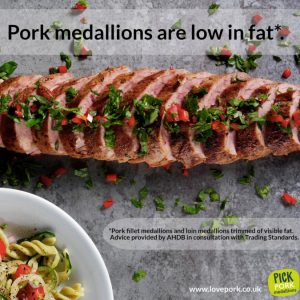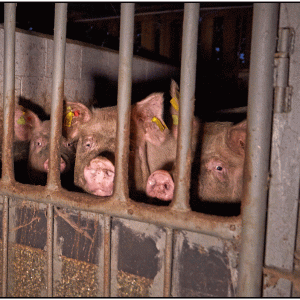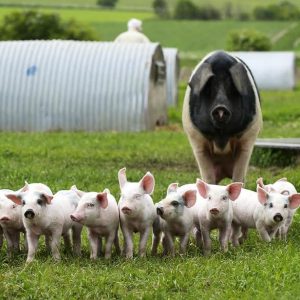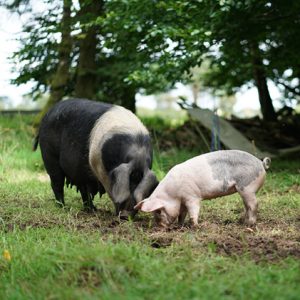Is there really any difference between organic chicken and non-organic chicken?
Written in collaboration with Farmdrop
Pork’s decline in popularity has been so slow you may not have noticed it – but farmers and supermarkets sure have. Around one million fewer households are now buying it, while sales of chicken, widely considered to be the healthy white meat, continue to soar. Why? Because of fears it’s not that healthy. But what it all comes down to, of course, is making sure you’re buying the best-quality pork.
In response to falling sales, a “Love Pork” marketing campaign was launched in 2018, which presents pork as healthy as chicken. It highlighted that a pork medallion contains a whole – wait for it – 0.03g less saturated fat than a skinless chicken breast.

Which is a great thing that means we can all eat pork as often as we do chicken. Right?
Well, not quite…
Sourcing the best-quality pork: how healthy is it?
As our articles on chicken reveal, there’s a lot more to the arguments for how “healthy” a meat is for you than a simplistic fat and protein content marketing message.
And there’s a huge range of pork out there, from intensively reared to free-range and organic.
So while “Love Pork” is not telling outright porkies, they’re not telling the whole truth either. How a pig is farmed has a significant impact on its nutritional value.
For example, the biggest nutritional difference between organic meat and non-organic is that organic meat contains around 50% more beneficial omega-3 fatty acids, according to a report published in the British Journal of Nutrition. Plus, organic meat was found to have slightly lower concentrations of two saturated fats linked to heart disease.
Organic and truly free-range pigs are reared without the routine use of drugs, antibiotics and wormers common in intensive farming.
This is especially important in light of reports highlighting how the overuse of antibiotics in farming is undermining the treatment of infections in humans.
So paying good money to buy the best-quality pork no longer seems unreasonable, it seems necessary.
Avoid intensive pig farming for the best-quality pork
A report by the Bureau of Investigative Journalism revealed that the number of intensive farms (housing 2,000 pigs for grown meat) in the UK has risen by 25% since 2011.
“Mega Farms” holding at least 2,500 pigs are also increasing at a concerning pace with the largest UK pig farm able to hold a staggering 23,000 pigs.
Intensive farming now accounts for an incredible 90% of all pork sold in the UK, according to Philip Lymbery, chief executive of Compassion in World Farming (CIWF).
When it comes to pigs, what passes as acceptable is pretty horrifying.
Warning: explicit content
Piglets are born to sows (mother pigs) in farrowing crates, which are so small the sows can’t even turn around.
The piglets compete with one another for teats that aren’t providing enough milk for them all, so they have their teeth painfully clipped to minimise damage when fighting to suckle.
Unstimulated, their tails will have been docked by the time they are transferred to pens at three weeks old (without anaesthetic if they were under seven days old) to stop them causing serious damage when they bite each other as their boredom turns to aggression.
The growing pigs live on hard slatted floors so their excrement can conveniently be washed away. Fed growth hormones to grow quickly, commercially reared pigs are ready for slaughter from five months old, twice as fast as higher welfare breeds which grow at a more natural pace.
They are fattened up on cereals. They are also fed routine antibiotics because diseases spread quickly in tightly packed conditions and they haven’t fed from their mother for long enough to build up immunity.
Welfare standards, highest to lowest:
Organic: Soil Association organic bans nose ringing (used to prevent natural rooting behaviour), tail docking, farrowing crates and the use of routine antibiotics.
Free-range: This is not a legal term when it comes to pigs, but should mean pigs are born and reared in outdoor systems.
In truly free-range systems, the standards are as high as organic when it comes to welfare. When used as a marketing gimmick, the welfare standards are lower and tooth clipping and tail docking are permitted.
RSPCA Assured: Pigs can be reared indoors.
Doesn’t allow the use of farrowing crates and has stricter requirements for tooth clipping and tail-docking.
Outdoor reared: Pigs are born and then reared in outdoor systems for around half their lives. The sows remain in the outdoor system throughout their life. Tooth clipping and tail docking are permitted.
Outdoor bred: Pigs are born in outdoor systems, but raised in barns after weaning.
The sows remain in the outdoor system throughout their life. Tooth clipping and tail docking are permitted.
Red Tractor: Certifies 85 per cent of pig farms in the UK. Farrowing crates, tooth clipping and tail docking are permitted.
A study by organic certification body Soil Association revealed 63% of pork samples contained antibiotic-resistant E. coli.
“In Britain, a nation of animal lovers, most of our pigs are in factory farms in conditions that in my view can only be described as utter deprivation,” says Compassion in World Farming’s Lymbery, who believes it’s supermarkets who have benefited from this centralisation of supply.

As meat has become cheaper than ever, farmers have been forced into levels of efficiency that have never been seen before – and that includes pushing animals to grow at unnatural rates.
As one farmer explains it: “That’s not a pig, that’s a genetic monster who’s lived in a shed all its life.”
“That’s not a pig, that’s a genetic monster that’s lived in a shed all its life.”
What’s the truth behind the labelling?
Over the last decade supermarkets have realised consumers want their animals to be treated better.
But let’s be clear: this doesn’t necessarily mean they have to treat the animals better – just market them to suggest this is the case.
“The advantages are some people are prepared to pay more money for it because they think it’s better welfare.” (David Clarke, Red Tractor)
Lymbery points to research that shows simply adding the word ‘fresh’ leads to around 30% of consumers believing products are more free-range than they actually are.
Even worse, when we asked David Clarke, former CEO of Red Tractor, which certifies 85% of pig farms in the UK, what are the advantages of “outdoor bred pork” – which means the pigs are born outdoors and raised indoors – his reply is:
“The advantages are some people are prepared to pay more money for it because they think it’s better welfare.”
And so, we unwittingly line the pockets of the corporations behind the farms rather than supporting the UK’s genuinely good farmers.

The best-quality pork comes from outdoor-reared pigs
At the other end of the spectrum, a luckier 10% of pigs are raised in truly higher-welfare, free-range and organic conditions.
If it’s cold, shelter with plenty of straw is their perfect hideaway. Given the opportunity to behave naturally, pigs on these farms will automatically designate themselves a toilet area – away from where they live and eat.
Pigs are very sociable animals and when given the chance they will happily spend their days grazing or rooting the ground with their sensitive snouts.
This style of farming goes hand-in-hand with passionate and enthusiastic farmers fighting to keep the rarest pig breeds in existence, like Gloucester Old Spot, The British Saddleback and The Tamworth.

At Fernhill Farm, there are just two Saddleback sister sows, who each have the potential to produce about 24 piglets a year. These animals get to live as a family unit in eight acres of land and rotate around the woodlands and gardens to cultivate, fertilise, clear scrub and help to reclaim unmanaged woodlands.
“We consider them as part of the team, clearing up windfall apples, garden and vegetable waste, weeds and consuming large quantities of fodder beet throughout winter,” says owner Jennifer Hunter. It’s not surprising that pigs with a life like this produce the best-quality pork.
“To us they form part of our holistic approach to farming rather than a stand alone business. Pigs were my first love after studying animal behaviour and they sure do deliver on bringing a bit of joy into our lives.”
The Saddleback is one of the original British breeds of pig and is gentle and quiet, perfectly suited to life outdoors – with great bacon potential.
British pigs are now 44% leaner than they were in the 1970s, while humans are 30% fatter. (AHDB)
Rare breeds have been phased out of commercial farms because they don’t grow quickly enough, but unsurprisingly the quality of the meat is incomparable.
It will have depth of colour and be full of flavour, fry beautifully in its own fat and it won’t release grungy water. Some British farmers are even turning rare breed meat into charcuterie – with impressive results.
Of course, meat from these pigs is more expensive – and some cuts can cost the same price as a steak. It’s a tough sell to re-educate consumers who have lost touch with how their food is really produced.
But, somewhat ironically, these pigs need to be eaten so they can continue to be farmed and ensure the survival of the breeds.

Going the whole hog
The rise in popularity of nose-to-tail eating means even a pig’s head now comes with a price tag of about £15, whereas butchers were literally giving them away a few years ago.
Yet the head is still the most undervalued part of the pig, according to chef James Golding, who uses it to make Bath-chaps (cured and smoked pork cheeks), braised cheeks and crispy ears.
As chef director of The Pig ‘restaurant with rooms’, who rear their own pigs, you’d expect Golding to be a big fan of pork.
“We finish our pigs on apples and it does transfer into the meat, it’s delicious.” (James Golding, chef)
“It is so versatile and tasty, whether you’re roasting a shoulder for dinner or making a paté, every product is packed full of flavour,” he says. “As long as it’s responsibly reared, it’s a beautiful meat.”
To Golding, the difference between the best-quality pork and cheap meat is huge. “The depth of flavour is the biggest difference and the smell is intense. We finish our pigs on apples and it does transfer into the meat, it’s delicious.”
This is where buying less common cuts, which are cheaper, can provide the best of both worlds, giving you access to the best-quality pork at a less eye-watering price tag. There are loads of great cuts of pork to choose from: the meaty chump, from the rump, is easy to cook in a pan or under the grill. The cheek, from the other end of the pig, is fatty and great in a stew. All in all, delicious reasons to pig out…

